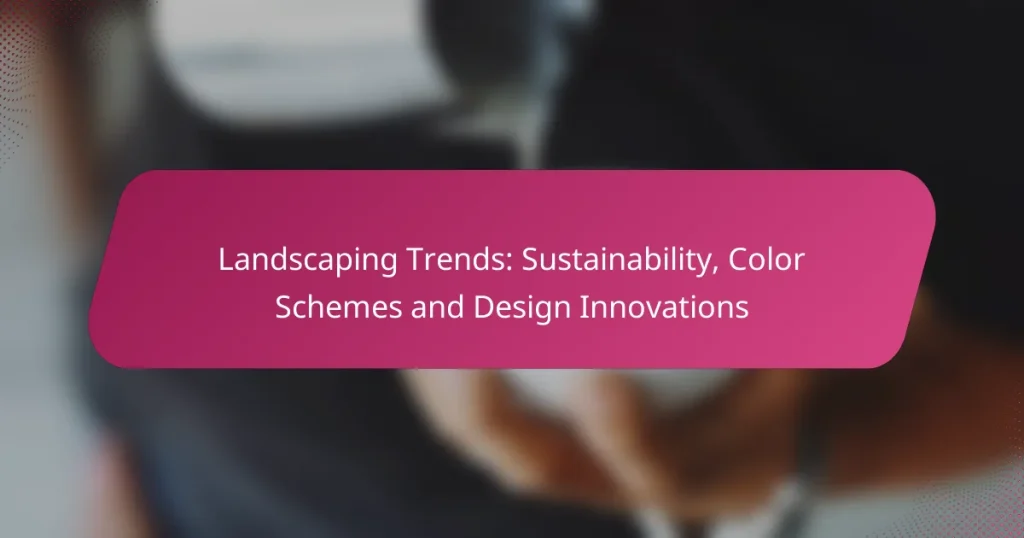As landscaping evolves, the latest trends emphasize sustainability, vibrant color schemes, and innovative design solutions. By integrating eco-friendly practices and native plants, outdoor spaces can thrive while minimizing environmental impact. Additionally, the strategic use of color enhances visual appeal and emotional resonance, while design innovations introduce smart technology and creative materials that redefine modern landscaping.
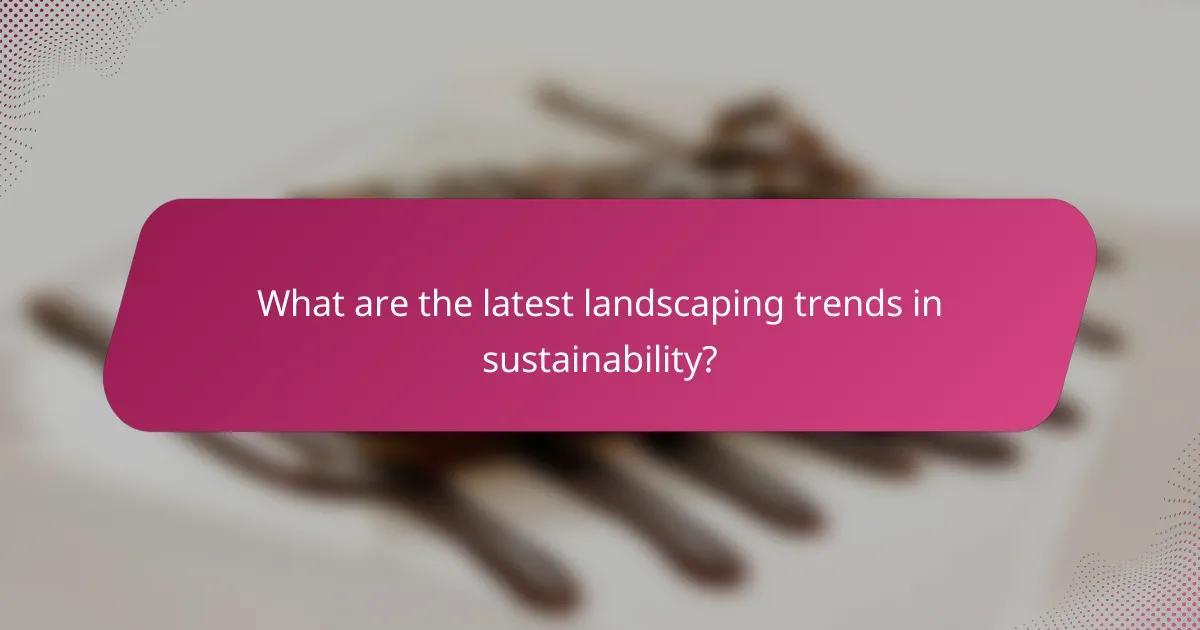
What are the latest landscaping trends in sustainability?
The latest landscaping trends in sustainability focus on eco-friendly practices that enhance biodiversity, conserve resources, and reduce environmental impact. These trends prioritize the use of native plants, efficient water management, and recycled materials to create beautiful, functional outdoor spaces.
Native plant landscaping
Native plant landscaping involves using plants that are indigenous to a specific area, which helps maintain local ecosystems. These plants are adapted to the local climate and soil conditions, requiring less water and maintenance compared to non-native species. Incorporating native plants can also attract local wildlife, such as pollinators and birds, enhancing biodiversity.
When selecting native plants, consider local resources or extension services that provide lists of suitable species for your region. This approach not only supports the environment but can also lead to lower landscaping costs over time.
Rain gardens for stormwater management
Rain gardens are designed to capture and absorb stormwater runoff, reducing flooding and improving water quality. These gardens typically feature native plants and are strategically placed in low-lying areas to collect rainwater from roofs, driveways, and other surfaces. By allowing water to infiltrate the ground, rain gardens help recharge groundwater supplies.
To create a rain garden, choose a location that receives runoff, dig a shallow depression, and fill it with native plants that thrive in wet conditions. This not only manages stormwater but also adds aesthetic value to your landscape.
Use of recycled materials
Using recycled materials in landscaping reduces waste and promotes sustainability. Common recycled materials include reclaimed wood for garden beds, crushed concrete for pathways, and recycled glass for decorative elements. These materials can add unique character to your landscape while minimizing the environmental footprint.
When sourcing recycled materials, check local suppliers or recycling centers for options that fit your design. Ensure that any materials used are safe and suitable for outdoor use to avoid future issues.
Low-water landscaping techniques
Low-water landscaping techniques focus on creating beautiful gardens that require minimal irrigation. This can be achieved through xeriscaping, which involves selecting drought-resistant plants, using mulch to retain moisture, and designing efficient irrigation systems. These practices are particularly beneficial in arid regions where water conservation is critical.
Consider grouping plants with similar water needs together and using drip irrigation systems to target water directly to the roots. This approach not only conserves water but can also reduce maintenance efforts.
Permaculture principles
Permaculture principles emphasize designing landscapes that work with nature rather than against it. This holistic approach includes creating self-sustaining ecosystems that provide food, habitat, and resources while minimizing waste. Key practices include companion planting, crop rotation, and integrating animals into the landscape.
To implement permaculture in your landscape, start by observing natural patterns and ecosystems in your area. Design your garden layout to mimic these patterns, which can lead to healthier plants and a more resilient landscape.
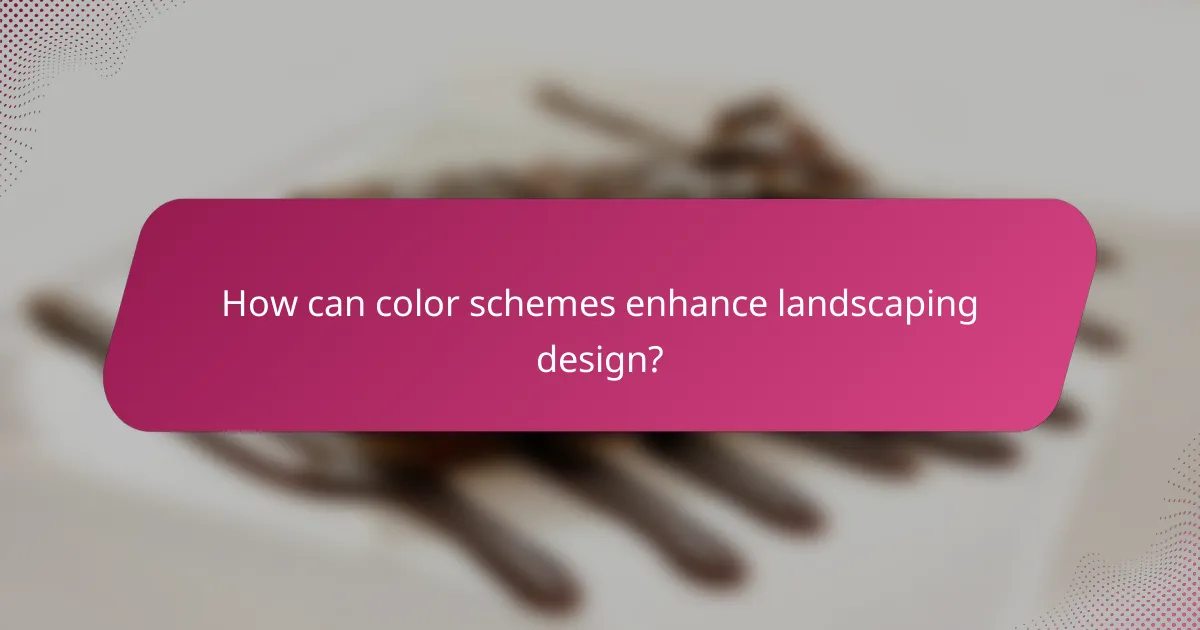
How can color schemes enhance landscaping design?
Color schemes play a crucial role in enhancing landscaping design by creating visual harmony and emotional impact. Thoughtful use of color can draw attention to specific areas, evoke certain feelings, and even influence the perceived size of a space.
Seasonal color palettes
Seasonal color palettes allow landscapes to evolve throughout the year, showcasing different hues and tones. For instance, spring may feature pastel blooms, while autumn can bring rich oranges and deep reds. Selecting plants that align with seasonal changes can create a dynamic and engaging outdoor space.
Consider incorporating perennials that bloom at different times to maintain color throughout the seasons. This approach not only enhances visual interest but also supports local wildlife by providing food sources year-round.
Contrasting foliage colors
Contrasting foliage colors can significantly enhance the depth and texture of a landscape. Dark greens paired with lighter hues create a striking visual effect that draws the eye. For example, combining dark-leaved plants with vibrant flowering species can highlight both elements effectively.
When planning for contrast, consider the overall layout and surrounding features. Using contrasting colors can help define pathways or focal points, making the landscape more navigable and visually appealing.
Color theory applications
Applying color theory in landscaping involves understanding how colors interact and affect perception. Complementary colors, which are opposite on the color wheel, can create vibrant and energetic spaces, while analogous colors, which are next to each other, tend to produce a more serene atmosphere.
Utilizing color theory can guide plant selection and placement. For instance, a garden designed with blue and yellow flowers can evoke a cheerful environment, while a palette of greens and blues may promote tranquility.
Popular color combinations for 2023
For 2023, popular color combinations include earthy tones paired with vibrant accents. Shades like terracotta and olive green are trending, complemented by pops of bright yellow or deep purple. This mix reflects a desire for natural aesthetics combined with lively touches.
Another favored combination is soft pastels with bold jewel tones, creating a balanced yet striking appearance. When choosing colors, consider the surrounding architecture and natural elements to ensure a cohesive look that enhances the overall landscape design.
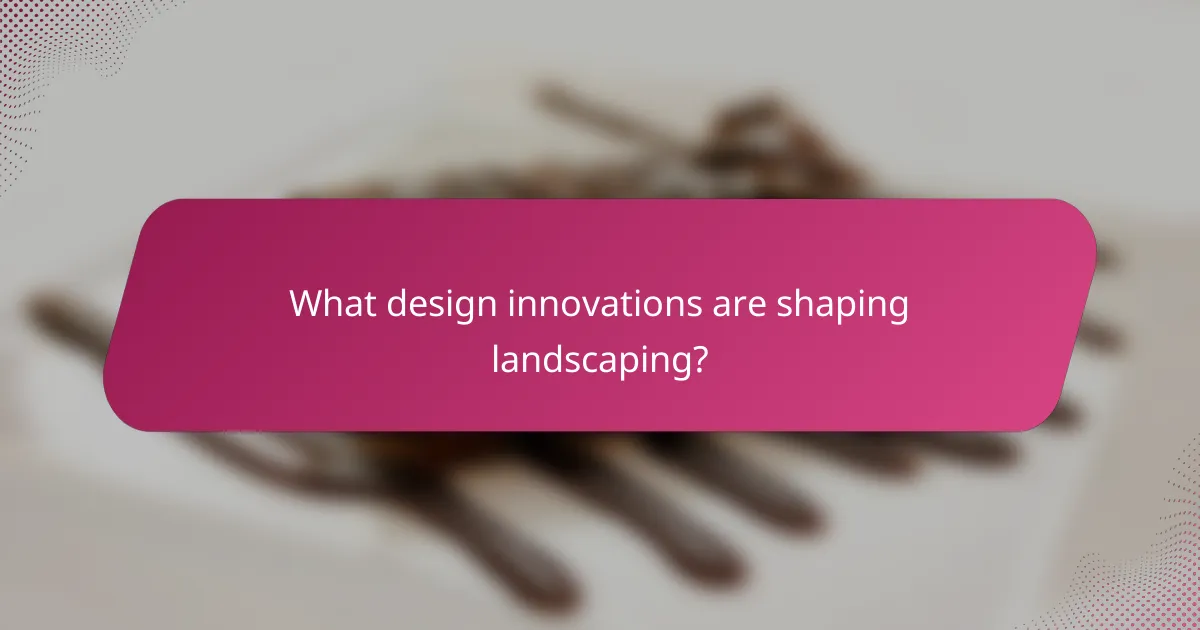
What design innovations are shaping landscaping?
Design innovations in landscaping focus on enhancing sustainability, functionality, and aesthetics. These advancements include smart technology, creative use of space, and eco-friendly materials that cater to modern environmental concerns.
Smart irrigation systems
Smart irrigation systems optimize water usage by using sensors and timers to adjust watering schedules based on weather conditions and soil moisture levels. This technology can significantly reduce water waste, making it an essential innovation for sustainable landscaping.
When considering a smart irrigation system, look for features like weather-based controllers and soil moisture sensors. These systems can save homeowners up to 50% on water bills while maintaining healthy landscapes.
Vertical gardens
Vertical gardens, or living walls, are innovative solutions that maximize space by growing plants vertically. This approach is particularly beneficial in urban areas where ground space is limited, allowing for greenery in small areas.
To create a vertical garden, choose a variety of plants that thrive in your local climate and consider using modular planting systems. These gardens not only enhance aesthetics but also improve air quality and provide insulation for buildings.
Outdoor living spaces
Outdoor living spaces extend the home’s usable area, integrating features like kitchens, dining areas, and lounges into the landscape. This trend emphasizes comfort and functionality, encouraging outdoor enjoyment year-round.
When designing an outdoor living area, consider durable materials that withstand weather conditions. Incorporating features like fire pits, pergolas, and comfortable seating can create inviting spaces for relaxation and entertainment.
Eco-friendly hardscaping
Eco-friendly hardscaping involves using sustainable materials and practices in the construction of non-plant elements like patios, walkways, and retaining walls. This approach minimizes environmental impact while enhancing the landscape’s functionality.
Common eco-friendly materials include permeable pavers, recycled concrete, and sustainably sourced wood. When planning hardscaping, ensure that designs promote water drainage and reduce runoff, contributing to a healthier ecosystem.

What are the benefits of sustainable landscaping?
Sustainable landscaping offers numerous advantages, including environmental protection, cost efficiency, and enhanced property value. By incorporating eco-friendly practices, homeowners can create beautiful outdoor spaces that are both functional and beneficial to the ecosystem.
Environmental impact reduction
Sustainable landscaping significantly reduces environmental impact by promoting biodiversity and minimizing resource consumption. Techniques such as xeriscaping, which uses drought-resistant plants, help conserve water and reduce the need for chemical fertilizers and pesticides.
Additionally, using native plants supports local wildlife and reduces the carbon footprint associated with transporting non-native species. Implementing rain gardens and permeable paving can further mitigate stormwater runoff, protecting local waterways.
Cost savings on maintenance
Investing in sustainable landscaping can lead to substantial cost savings on maintenance over time. By selecting low-maintenance plants and employing efficient irrigation systems, homeowners can reduce water bills and labor costs associated with upkeep.
For example, a well-planned landscape with native plants may require less frequent watering and fewer chemical treatments, leading to lower ongoing expenses. This approach not only saves money but also lessens the environmental burden of maintaining traditional lawns.
Increased property value
Properties with sustainable landscaping often see an increase in value due to their aesthetic appeal and eco-friendly features. Buyers are increasingly interested in homes that offer sustainable outdoor spaces, which can differentiate a property in a competitive market.
Research indicates that well-designed landscapes can enhance property values by a significant percentage, making them a worthwhile investment. Features such as native plant gardens, efficient irrigation systems, and outdoor living spaces can attract potential buyers and justify higher asking prices.
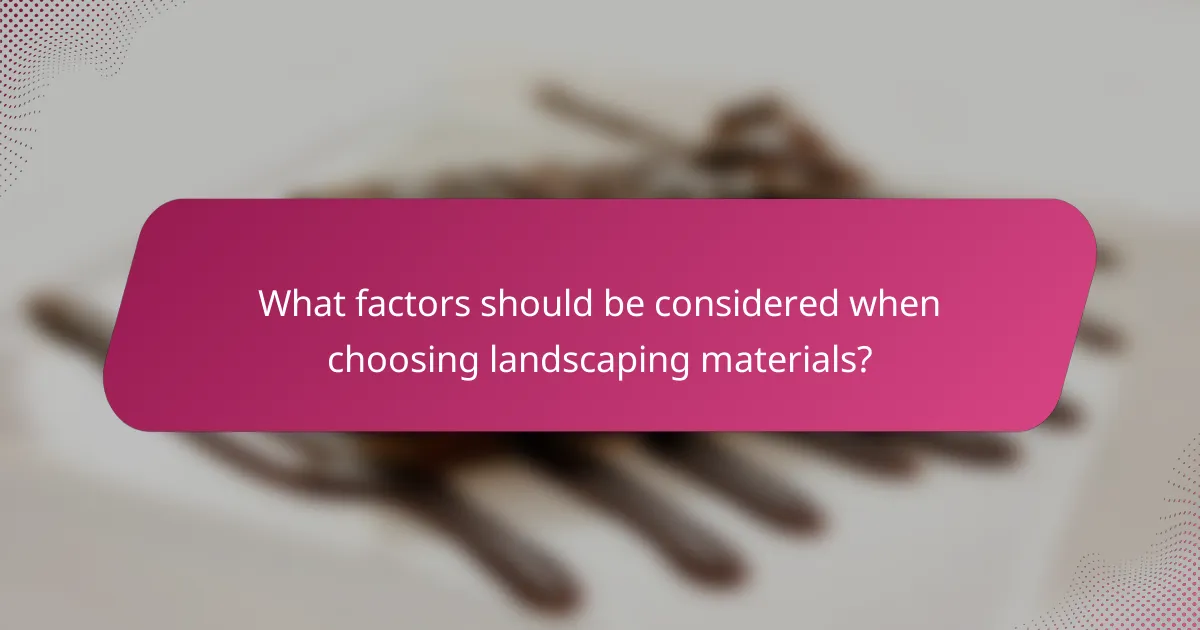
What factors should be considered when choosing landscaping materials?
When selecting landscaping materials, consider durability, environmental impact, maintenance needs, and aesthetic appeal. These factors will help ensure that your landscape design is both functional and visually pleasing over time.
Durability and lifespan
Durability refers to how well landscaping materials withstand weather conditions, wear, and tear over time. Choosing materials with a longer lifespan can reduce replacement costs and maintenance efforts.
For example, natural stone and brick typically offer high durability and can last for decades, while wood may require more frequent replacement due to rot or insect damage. Consider local climate conditions when evaluating material longevity; for instance, materials that perform well in humid areas may not be suitable for arid climates.
To ensure you select durable materials, look for products that meet industry standards for weather resistance and longevity. Always check for warranties or guarantees, as these can provide insight into the expected lifespan of the materials you choose.
